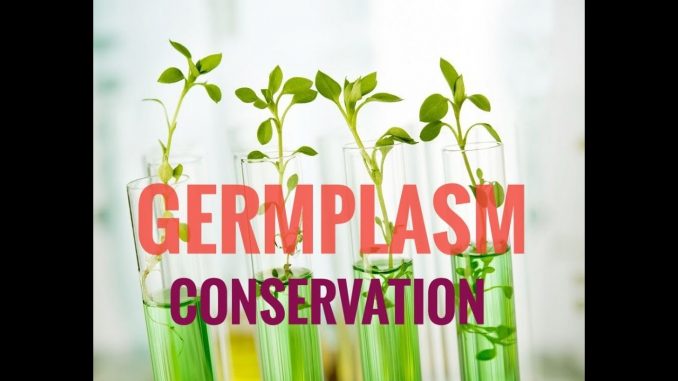
Importance of Germplasm conservation:
- Germplasm in a broad way can be defined as the hereditary material i.e. total content of genes which is inherited by the off springs through germ cells.
- Germplasm serves as the raw material for the breeder to produce various crops. Therefore, conservation of germplasm has importance in all breeding programmes.
- In previous days, humans gained the knowledge about the use of plants for food , shelter and many more, thus they started saving selected seeds or vegetative propagules from one season to the next one. The possibility of life on earth is mainly due to the plants as it is the crucial component of the ecosystem, thus its preservation is our responsibility for the continuation of life.
- In other words, it may be regarded as the conventional germplasm preservation and management, which is highly precious in breeding programmes.
- The main objective of germplasm conservation is to preserve the genetic diversity of selected plants or genetic stock for its utilization at any time in future.
- In recent years, the primitive and conventionally used agricultural plants are being replaced by many new plant species with desired and improved characteristics.
- It is very crucial to conserve the endangered plants otherwise some of the important genetic traits possessed by the primitive plants may be lost.
- It has been estimated that up to 100,000 plants, depicting more than one third of all the world’s plant species, are currently threatened or face extinction in the wild.
- Biodiversity is seriously threatened, particularly, in Europe.
- Biotechnological approaches provide several conservation possibilities which have the potential to support in situ protection strategies and provide complementary conservation options.
- International Board of Plant Genetic Resources (IBPGR), a global body has been established for germplasm conservation.
- Its main aim is to provide essential support for collection, conservation and utilization of plant genetic resources all over the world.
Types of germplasm conservation:
There are mainly two types of germplasm conservation which are
- In-situ conservation
- Ex-situ conservation
In-situ conservation:
- The conservation of germplasm in their natural habitat by constructing national parks/gene sanctuaries is termed as in-situ conservation.
- It is regarded as a high priority germplasm preservation programme.
- It helps in the continuation of plant life in the ecological community.
- It aims in conservation of great number of cultivated and wild species in less area.
- One of the advantages of in-situ conservation is that it continues the evolution of the species along with the allowance of appearance of new recombinant form.
- limitations of in-situ conservation
- Security is very low in absence of controlled monitoring.
- Various environmental hazards can degrade the germplasm.
- Expensive maintenance cost for large number of genotypes.
Ex-situ conservation:
- The genetic materials can be conserved either by collecting plants and kept in normal growing conditions or in the form of seeds in seed banks, through tissue culture and low temp maintained by liquid N2. This type of conservation is termed as ex-situ conservation.
- It is the major method for the preservation of germplasm obtained from both wild and cultivated plant materials.
- Genetic resources either in form of seeds or plants cells, tissues or organs can be preserved as gene banks for long term storage under favourable conditions.
- Proper knowledge of plant diversity, their genetic structure and the methods involved in sampling, regeneration, maintenance of gene pools is important for the successful accomplishment of gene banks.
- Ex-situ conservation cannot allow the plants to continue its evolutionary process but it ensures the availability of stored genetic materials in need and its safety.
- Sugarcane, cocoa and rubber are stored in this way.
Technique of Germplasm conservation
Seeds conservation:
- Usually, seeds are the most efficient, simple, economic and convenient resources to conserve plant germplasm.
- This is because many plants are regenerated through seeds, and seeds cover relatively small space. In addition, seeds can be easily moved to various places.
- Seed conservation is the most broadly used method of ex-situ conservation.
- It is performed by drying the seeds at 10-25°C, 10-15% relative humidity followed by storage at -18°C.
- limitations:
- Viability of seeds is decreased or lost along with time.
- Seeds are destructed by insect or pathogen attack.
- This approach is only confined to seed propagating plants, and thus it is useless for vegetatively propagated plants e.g. potato, Ipomoea, Dioscorea.
- Heterogenous seeds are not suitable for true genotype maintenance.
- Only orthodox seeds can be conserved by this method as the recalcitrant and intermediate seeds cannot stand the dessication.
